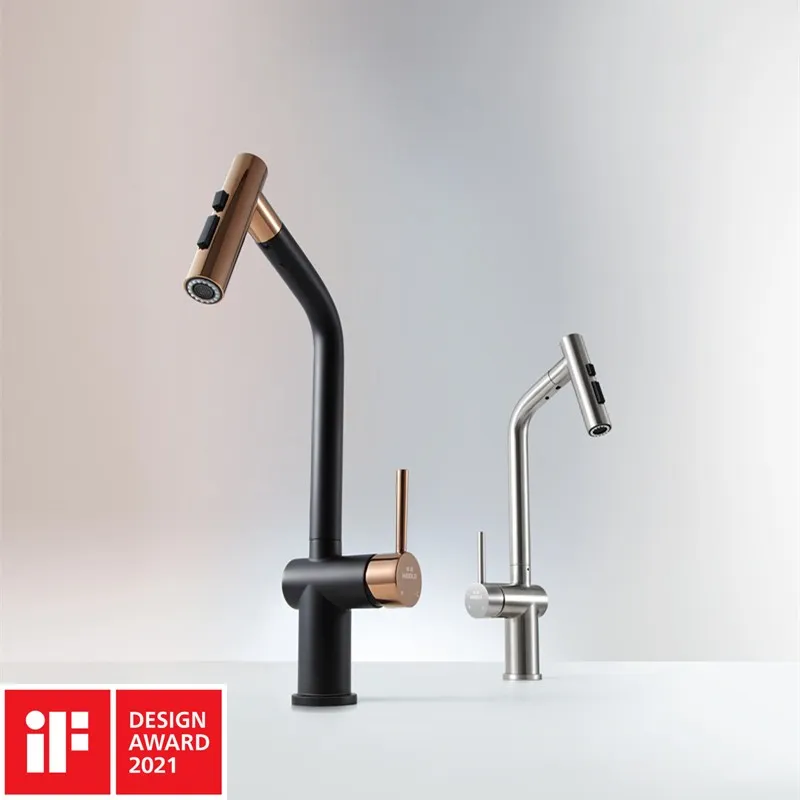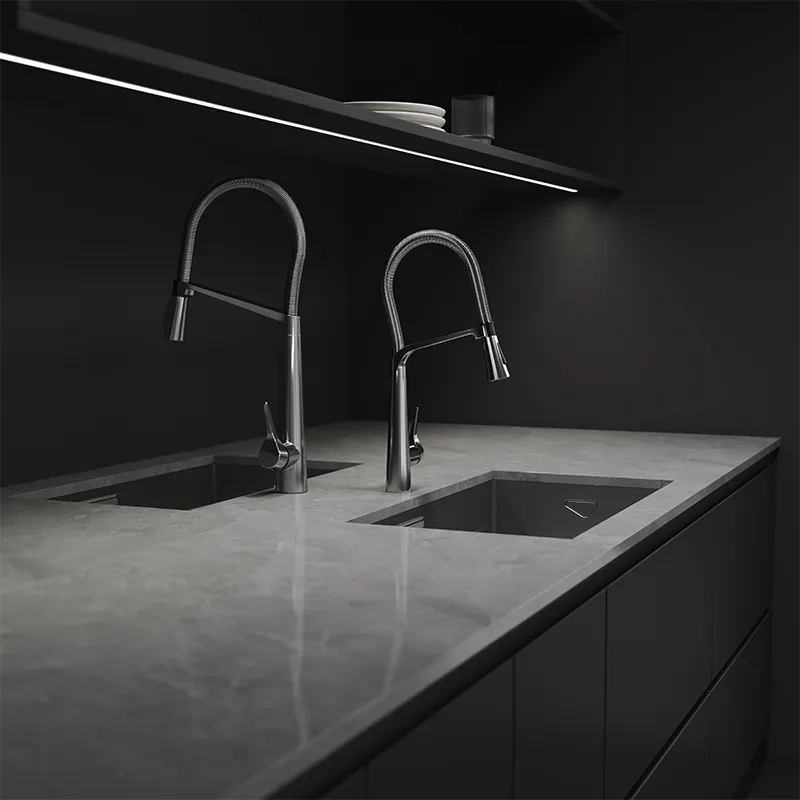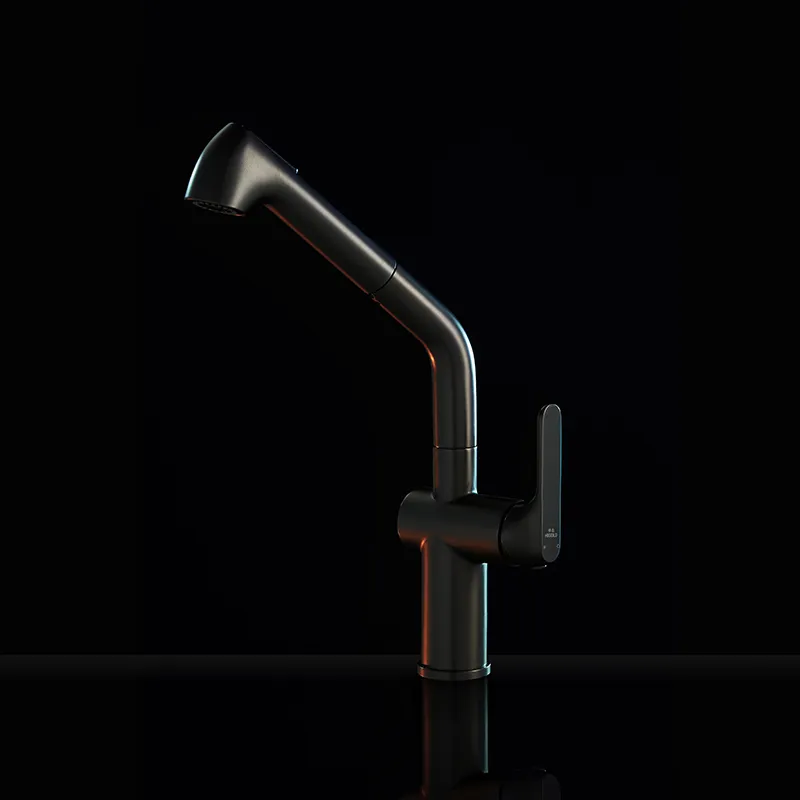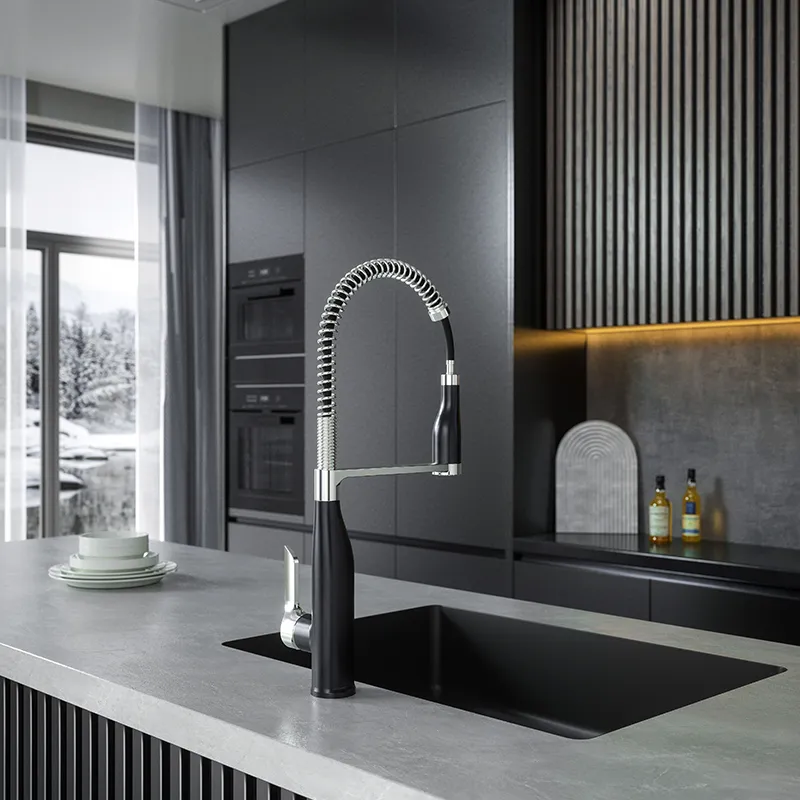Kitchen faucets not only serve a practical function but are also a crucial visual element of the kitchen space. In recent years, black kitchen faucets have gradually become a focus for designers and consumers due to their unique visual impact and fashionable appeal.
Black kitchen faucets can visually contrast with cabinets and countertops, creating a sophisticated, modern, and high-end spatial effect. However, many consumers have doubts when choosing a black faucet: Is a black kitchen faucet suitable for my kitchen? Are there any maintenance difficulties or potential problems during use?
This article will analyze whether a black kitchen faucet is a worthwhile kitchen solution from multiple perspectives, including materials, craftsmanship, and design advantages, to help consumers make a rational decision.

Black Kitchen Faucets: What are the Materials and Craftsmanship?
1. Main Material Analysis
The material of a black kitchen faucet directly affects its durability, appearance, and lifespan. Common materials include:
• Stainless Steel: Stainless steel is the preferred material for high-quality faucets. After black spraying or PVD coating, it can present a matte or glossy black effect. Stainless steel faucets offer superior corrosion resistance, high temperature and wear resistance, and high compressive strength. Their black surface treatment maintains its gloss and uniformity for a long time, but low-quality spraying processes may result in fading or scratches during use.
• Copper: Copper faucets often use a black electroplating process, possessing natural antibacterial properties, and copper itself is highly resilient. Electroplated or oxidized black faucets exhibit excellent corrosion resistance and aesthetics. However, uneven surface treatment may lead to color variations or localized fading.
• ABS Plastic or Composite Materials: ABS plastic or composite material faucets are characterized by low cost and light weight, but their wear resistance and high temperature resistance are relatively limited. A black surface coating may meet short-term aesthetic needs, but long-term use may result in scratches, fading, or loss of surface gloss.
2. Surface Treatment Process
The aesthetics and durability of black kitchen faucets largely depend on the surface treatment process. Common processes include:
• PVD Vacuum Coating: PVD (Physical Vapor Deposition) coating is currently the most wear-resistant and strongest adhesion surface treatment for black faucets. During the coating process, metal vapor is deposited on the faucet surface in a vacuum environment, forming a stable black protective layer. This process effectively prevents oxidation and scratches, maintaining color for a long time.
• Electrostatic Spraying and Powder Coating: Spraying is suitable for economical kitchen faucets, offering low cost and achieving matte or glossy black effects. However, the coating thickness is limited, and it is prone to localized peeling or scratches due to friction or improper cleaning.
• Electroplating and Oxidation Treatment: Electroplating forms a metallic protective film on the surface of black faucets, improving corrosion resistance and wear resistance; oxidation treatment strengthens surface hardness through chemical reactions while imparting a certain black texture, but its color stability is slightly lower than PVD coating.
Therefore, the choice of materials and processes directly determines the lifespan and aesthetics of black kitchen faucets. High-quality faucets typically use copper or stainless steel with a PVD coating, while low-cost products are mostly made of ABS and use a spray coating process, resulting in differences in long-term performance.

What are the advantages of black kitchen faucets?
1. Significant Aesthetic Effect
Black kitchen faucets, with their strong visual presence, can be the finishing touch to a kitchen design. Against a light-colored countertop or white cabinet background, a black faucet creates contrast, enhancing the sense of space and modernity; against a dark countertop or dark cabinet environment, a black kitchen faucet can create a unified and stable design style, enhancing the overall quality of the space.
2. Superior Stain Resistance
Compared to bright or metallic faucets, black kitchen faucets are less prone to water stains and fingerprints during daily use, especially matte black surfaces, which maintain a clean and tidy visual effect. This provides convenience for daily household maintenance, reducing the need for frequent wiping.
3. Strong Style Adaptability
Black kitchen faucets can adapt to a variety of kitchen design styles, from modern minimalist to industrial to high-end luxury. It not only coordinates well with dark cabinets and countertops but also serves as a visual focal point, highlighting the kitchen's layers.
4. Combining High-End Feel and Texture
The understated color of a black kitchen faucet enhances the overall sophistication of the kitchen, making the space appear upscale and elegant. Meanwhile, modern craftsmanship gives the faucet a metallic or matte finish, providing a comfortable touch and a pleasant user experience.

What are the potential problems with black kitchen faucets? —Disadvantages
1. Surface Scratches and Maintenance Difficulty
While black kitchen faucets are stain-resistant, if the surface material is spray-coated or has a low-quality electroplating layer, it is prone to scratches due to friction or improper cleaning during use. Once scratches form, the black surface may show a metallic undertone or lose its shine, affecting the overall aesthetics.
2. Color Uniformity Issues
Low-quality black kitchen faucets may exhibit uneven coloring, such as areas that are too black or too gray, especially noticeable in spray-coated areas. This color difference affects the visual appeal and diminishes the design sense of the black faucet.
3. Cleaning Misconceptions
Some users may believe that black faucets don't get dirty easily and therefore neglect daily cleaning. However, long-term accumulation of grease, limescale, and dust can still cause the surface to become dull or fade in certain areas. Using steel wool, strong acid or alkali cleaners, or hard-bristled brushes can easily damage the surface protective layer and accelerate aging.
4. Kitchen Style Limitations
While black kitchen faucets are versatile, they can appear jarring in light-colored country or Scandinavian style kitchens if not properly matched. In poorly designed kitchens, black faucets can disrupt the overall color balance, making the kitchen appear heavy or oppressive.
Black Kitchen Faucets: Professional Buying Advice
1. Material Priority
Prioritize stainless steel or copper faucets for both durability and safety. High-quality materials combined with advanced surface treatment processes ensure long-term colorfastness and wear resistance.
2. Surface Finish Selection
PVD coating offers the strongest wear resistance, adhesion, and color stability for black faucets; high-quality spraying or electroplating processes are secondary, but require careful use and maintenance. Before purchasing, carefully check the surface treatment quality and manufacturing process of the faucet.
3. Functional and Design Considerations
Black faucets should not only be aesthetically pleasing but also functional. Features such as retractable spouts, hot and cold water controls, and filter interfaces ensure convenient daily use and versatility.
4. Ease of Cleaning and Maintenance
When purchasing, pay attention to whether the kitchen faucet surface is easy to clean and resistant to everyday neutral detergents and mild acidic or alkaline liquids, ensuring it maintains its black luster even after long-term use.
5. Overall Kitchen Color Scheme
Black faucets should coordinate with the colors of countertops, cabinets, and floor tiles, creating both contrast and a unified style. Designers recommend conducting color matching simulations before purchasing to avoid color clashes or style inconsistencies.

Black Kitchen Faucets: How to Maintain Them Properly? —Methods
1. Daily Cleaning: Wipe the faucet with a soft cloth and warm water to keep the surface clean. Avoid using steel wool, hard-bristled brushes, or detergents containing strong acids or alkalis, as these can damage the surface protective layer.
2. Regular deep cleaning: Use a neutral detergent or a mixture of a small amount of vinegar and warm water to gently wipe the faucet surface to remove limescale, grease, and dust, maintaining the shine of the black surface.
3. Avoid sharp impacts: Avoid contact with metal cookware, knives, or heavy objects during use to prevent scratching the surface protective layer and affecting its appearance.
4. Control kitchen humidity: Maintain kitchen ventilation to reduce the long-term adhesion of water vapor to the faucet surface, helping to prevent localized corrosion and dulling of the color.
5. Pay attention to the cleaning order: When cleaning the sink and faucet, clean the sink first, then the faucet, to avoid chemical residue contaminating the faucet surface.
Is a black kitchen faucet a good idea?
Absolutely. A black kitchen faucet is an excellent design choice that combines aesthetics and practicality. It can add a modern touch to the kitchen space, enhance the overall texture, and has the advantages of being relatively stain-resistant and easy to match with other elements. However, its long-term aesthetics and user experience depend on the materials, surface treatment process, and maintenance methods.
High-quality black faucets combine stainless steel or copper with a PVD coating process, ensuring a long-lasting black sheen and durability. However, while low-cost spray-painted or plastic faucets may be aesthetically pleasing, they are prone to scratches, fading, or insufficient durability.
What technology is used in Higold’s handmade sink production?
Our factory has pioneered four key technologies in handmade sink manufacturing: automatic r-angle processing, robotic bending, automated edge grinding, and robotic arm welding. These processes deliver precise finishing and consistent quality. Buyers who purchase wholesale from Higold receive products that combine traditional craftsmanship with cutting-edge innovation, all available at factory prices with ODM customization options.


